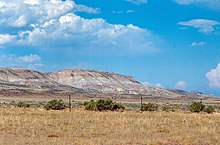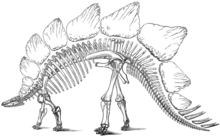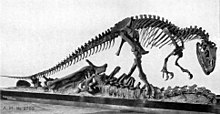This is an old revision of this page, as edited by Jappalang (talk | contribs) at 07:48, 29 August 2008 (Copyedit). The present address (URL) is a permanent link to this revision, which may differ significantly from the current revision.
Revision as of 07:48, 29 August 2008 by Jappalang (talk | contribs) (Copyedit)(diff) ← Previous revision | Latest revision (diff) | Newer revision → (diff)
The Bone Wars is the name given to a period of intense fossil speculation and discovery in the United States of America during the Gilded Age of American history, fueled by a heated rivalry between Edward Drinker Cope and Othniel Charles Marsh. The two paleontologists used underhanded methods to out-compete the other in the field, resorting to bribery, theft, and destruction of bones. The scientists also attacked each other in scientific publications in attempts to ruin the other's credibility and cut off their funding.
Originally colleages who were civil to each other, Cope and Marsh became bitter enemies after several personal slights between them. Their pursuit of bones led them west to rich bone beds in Colorado, Nebraska, and Wyoming. Both paleontologists used their wealth and influence to hire dinosaur hunters to send them fossils, or to finance their own expeditions. The digging lasted from 1877 to 1892, by which time both men had exhausted their funds.
Cope and Marsh were financially and socially ruined by their efforts to disgrace each other, but their contributions to science and the field of paleontology were massive; the scientists possessed tons of unopened boxes of fossils between them after their deaths. The feud between the two men led to over 142 new species of dinosaurs being discovered and described. The products of the Bone Wars resulted in an increase in knowledge of ancient life, and sparked the public's interest in dinosaurs, leading to continued fossil excavation in North America in the decades to come. The Bone Wars have also been the subject of both historical books and fictional adaptations.
History
Background
At one time, Cope and Marsh were friends. The two had met in Berlin, Germany in 1864, and spent several days together. They even named species after each other. Over time, however, their relations soured, due in part to their temperaments. Cope was known to be pugnacious and possessed a quick temper; Marsh was slower and more methodical, and despite his powerful friends was very introverted. Both were quarrelsome and distrustful. The two men's scientific theories were on occasion drastically different; Cope was a firm supporter of Neo-Lamarckism, while Marsh supported Charles Darwin's theory of evolution by natural selection. Even while friends, both men were inclined to look down on each other subtly. As one observer put it, "The patrician Edward may have considered Marsh not quite a gentleman. The academic Othniel probably regarded Cope as not quite a professional."
Cope and Marsh came from very different backgrounds. Cope was born into a wealthy and influential Quaker family based in Philadelphia. While his father wanted his son to work as a farmer, Cope instead distinguished himself as a naturalist. In 1864, Cope became a professor of zoology at Haverford College and joined Ferdinand Hayden on his expeditions west. Marsh would have grown up poor, the son of a struggling family in Lockport, New York, had it not been for the benefaction of his uncle, philanthropist George Peabody. Marsh persuaded his uncle to build the Peabody Museum of Natural History, placing Marsh as head of the museum. Combined with the inheritance he received from Peabody upon his death in 1869, Marsh was financially comfortable (although due in part to Peabody's stern views on marriage, Marsh would remain a lifelong bachelor.)
On one occasion, the two scientists had gone on a fossil-collecting expedition to Cope's marl pits in New Jersey, where William Parker Foulke had discovered the holotype specimen of Hadrosaurus foulkii, described by the paleontologist Joseph Leidy; this was one of the first American dinosaur finds, and the pits were still rich with fossils. Though the two parted amicably, Marsh secretly bribed the pit operators to divert the fossils they were discovering to him, instead of Cope. The two began attacking each other in papers and publications, and their personal relations soured. Marsh humiliated Cope by pointing out his reconstruction of the plesiosaur Elasmosaurus was flawed, with the head placed where the tail should have been. Cope, in turn, began collecting in what Marsh considered his private bone-hunting turf in Kansas and in Wyoming. Any pretense of cordiality between the two ended in 1872, and open hostility ensued.
Como Bluff and the West
In the 1870s, both Cope and Marsh's professional attentions were directed to the American West by word of large fossil finds. In 1877, Marsh received a letter from Arthur Lakes, a schoolteacher in Golden, Colorado. Lakes reported that he had been hiking in the mountains near the town of Morrison when he and H. C. Beckwith, his friend, had discovered massive bones embedded in the rock. Lakes wrote in his letter that the bones were "apparently a vertebra and a humerus bone of some gigantic saurian." While awaiting Marsh's reply, Lakes dug up more "colossal" bones and sent them to New Haven. As Marsh was slow to respond, Lakes also sent a shipment of bones to Cope.

When Marsh responded to Lakes, he paid the prospector $100, urging him to keep the finds a secret. Learning that Lakes had corresponded with Cope, Marsh sent his field collector Benjamin Mudge to Morrison to secure Lake's services. At the same time Marsh published a description of Lake's discoveries in the American Journal of Science on July 1, and before Cope could publish his own interpretation of the finds, Lakes wrote to him that the bones should be shipped to Marsh, a severe insult to Cope.
A second letter arrived from the West, this time addressed to Cope. O.W. Lucas was a naturalist who had been collecting plants near Cañon City, Colorado, when he came upon an assortment of fossil bones. After receiving more samples from Lucas, Cope concluded the dinosaurs were large herbivores, larger than any other specimen described at the time. Marsh heard of Lucas' finds and instructed Mudge and his former student Samuel Wendell Williston to set up his own quarry near Cañon. Unfortunately for Marsh, he learnt from Williston that Lucas was finding the best bones and had refused to quit Cope to work for him.
At the same time, the Transcontinental Railroad was being built through a remote area of Wyoming. Marsh received a letter from two men identifying themselves as Harlow and Edwards (their real names were Carlin and Reed), workers on the Union Pacific Railroad. The two men claimed they had found large amounts of fossils in Como Bluff, and warned that there were others in the area "looking for such things", which Marsh took to mean Cope. Marsh sent Williston to the site, who sent a message to Cope that both the large quantities of bones, and the reports of Cope's men snooping around in the area were true. Without delay both Cope and Marsh sent their men to Como Bluff to begin digging.
Cope and Marsh used their personal wealth to fund expeditions each summer, then spent the winter publishing their discoveries. Small armies of fossil hunters in mule-drawn wagons or on trains were soon sending literal tons of fossils back East. The digging lasted fifteen years, from 1877 to 1892.

Cope and Marsh's discoveries were accompanied by sensational accusations of spying, stealing workers and fossils, and bribery. The two men were so protective of their digging sites that they would destroy smaller or damaged fossils to prevent them from falling into their rival's hands, or filled in their excavations with dirt and rock. While the scientific community had long known of Marsh and Cope's rivalry, the public became aware of the shameful conduct of the two men on January 12, 1890, when the New York Herald published a story with the headline "Scientists Wage Bitter Warfare." According to author Elizabeth Noble Shor, the scientific community was galvanized:
Most scientists of the day recoiled in horror—and read on with interest, to find that Cope's feud with Marsh had at last become front-page news. Those closest to the scientific fields under discussion, geology and vertebrate paleontology, certainly winced, particularly as they found themselves quoted, mentioned, or misspelled. The feud was not news to them, for it had lurked at their scientific meetings for two decades. Most of them had already taken sides.
Personal disputes
While Cope and Marsh dueled for fossils in the American West, they also tried their best to ruin each others' professional credibility. Humiliated by his error in reconstructing the plesiosaur Elasmosaurus, Cope tried to cover up his mistake by purchasing every copy he could find of the journal it was published in. Marsh, who pointed out the error in the first place, made sure to publicize the story. Cope's own rapid and prodigious output of scientific papers meant that Marsh had no difficulty in finding occasional errors to lambast Cope with. Marsh was by no means more infallible; he put the wrong skull on a skeleton of Apatosaurus and declared it a new genus, Brontosaurus.
Over the years, Cope kept an elaborate journal of mistakes and misdeeds that both Marsh and John Wesley Powell, head of the U.S. Geological Survey (and Marsh's ally), had committed; the mistakes and errors of the men were put in writing and ensconced in the bottom drawer of Cope's desk. Reporter William Hosea Ballou ran the first article on January 12, 1890, in what would become a series of newspaper debates between Marsh, Powell and Cope.
Cope was by this time a teacher at the University of Pennsylvania, having been largely deprived of funding from the U.S. Geological Survey whom Cope had done freelance work for years earlier. Marsh was now a participant in the Survey and still the head of the Peabody Museum of Natural History. In the newspaper articles, Cope attacked Marsh for plagiarism and financial mismanagement and attacked Powell for his geological classification errors and misspending of government allocated funds. Marsh and Powell were each able to publish their own side of the story and in the end little changed between them. No congressional hearing was created to investigate the misallocation of funds by Powell and neither Cope nor Marsh was held responsible for any of their mistakes. Marsh was however quickly removed from his position as paleontologist for the government surveys, Cope's relations with the president of the University of Pennsylvania soured, and the entire funding for paleontology in the government surveys was pulled.
Legacy


Judging by pure numbers, Marsh "won" the Bone Wars. Both scientists made finds of incredible scientific value, but while Marsh discovered a total of 80 new dinosaur species, Cope discovered only 56. Among the specimens the two men discovered are the most well-known dinosaurs today, including species of Triceratops, Allosaurus, Diplodocus, Stegosaurus, Camarasaurus and Coelophysis. Cope and Marsh's cumulative discoveries defined the then-nascent field of paleontology; before Cope and Marsh's discoveries, there were only nine named species of dinosaur in North America. Furthermore, some of their ideas—such as Marsh's argument that birds are descended from dinosaurs—have been upheld; while others, including "Cope's law", which states that over time species tend to get larger, are viewed as having little to no scientific merit. The Bone Wars also led to the discovery of the first complete skeletons, and the rise in popularity of dinosaurs with the public. As paleontologist Robert Bakker stated, "The dinosaurs that came from not only filled museums, they filled magazine articles, textbooks, they filled people's minds."
Cope and Marsh's rivalry lasted until Cope's death in 1897, by which time both men had been financially ruined. Cope faced a series of financial setbacks, both from the lack of federal funding as well as failed business investments in silver mines; he had to sell part of his collection and rent out one of his homes. Marsh in turn had to mortgage his home and ask Yale for a salary to live on. Cope issued a final challenge at his death. He had his skull donated to science so that his brain could be measured, hoping that his brain would be larger than that of his adversary; at the time, it was thought brain size was the true measure of intelligence. Marsh never rose to the challenge, and Cope's skull is reportedly still preserved at the University of Pennsylvania. (Whether the skull stored at the University is Cope's is disputed; the University stated that it believes the real skull was lost in the 1970s, although Robert Bakker has said that hairline fractures on the skull and coroner's reports verify the skull's authenticity.)
The Bone Wars had a negative impact not only on the two scientists but their peers and the entire field. Their animosity and public behavior harmed the reputation of American paleontology in Europe for decades. Furthermore, the reported use of dynamite and sabotage by employees of both men destroyed or buried hundreds of potentially critical fossil remains. Joseph Leidy abandoned his more methodical excavations in the West, finding he could not keep up with Cope and Marsh's reckless search for bones.
Recent excavation of several of Cope and Marsh's sites suggest that some of the damage propagated by the two paleontologists was less than what has been recorded. Using Lakes' field paintings, researchers from the Morrison Natural History Museum discovered that Lakes had not actually dynamited the most productive quarries in Colorado; rather, Lakes had just filled in the site. Museum director Matthew Mossbrucker theorized that Lakes propagated the lie "because he didn't want the competition up at the quarry—playing mind games with Cope's gang.
Adaptations
Besides being the focus of historical and paleontological books, the Bone Wars has been the subject of a graphic novel, Bone Sharps, Cowboys, and Thunder Lizards, by Jim Ottaviani. Bone Sharps is a work of historical fiction, as Ottaviani introduces the character of Charles R. Knight to Cope for plot purposes, and other events have been restructured. The Bone Wars was featured in more fantastical form, in the book Bone Wars by Brett Davis, which includes aliens also interested in the bones.
Notes
- ^ Dodson.
- Bryson, 92.
- ^ Academy of Natural Sciences.
- ^ Limerick, et al, 7.
- Preston, 60.
- Bryson, 93.
- ^ Preston, 61.
- ^ Penick.
- Wilford, 87.
- Wilford, 105.
- ^ Wilford, 106.
- ^ Wilford, 107.
- Wilford, 108.
- Preston, 62.
- ^ Bates.
- ^ Bakker.
- ^ Preston, 63.
- Shor.
- Jaffe, 15.
- Rajewski, 22.
- Osborn, 585.
- Osborn, 403.
- Farlow, 709.
- Osborn Osborn, 404.
- Jaffe, 329.
- Norell, 112.
- ^ Colbert, 93.
- Trefil, 95.
- Baalke.
- Limerick, 8.
- Rajewski, 21.
- Mondor.
- Waggoner.
References
- Baalke, Ron (1994-10-13). "Edward Cope's Skull". lepomis.psych.upenn.edu (Mailing list). Retrieved 2008-08-15.
{{cite mailing list}}: Unknown parameter|mailinglist=ignored (|mailing-list=suggested) (help) - Bates, Robin (series producer), Chesmar, Terri and Baniewicz, Rich (associate producers); Feldon, Barbara (narrator) (1992). The Dinosaurs! Episode 1: "The Monsters Emerge" (TV-series). PBS Video, WHYY-TV.
{{cite AV media}}: External link in|title= - Bryson, Bill (2003). "Science Red in Tooth and Claw". A Short History of Nearly Everything. United States of America: Random House. ISBN 0-7679-0818-X.
- Colbert, Edwin (1984). The Great Dinosaur Hunters and Their Discoveries. Courier Dover Publications. ISBN 0-486-24701-5.
- Dodson, Peters, Bakker, Robert (interviewees) (1992). The Dinosaurs! Episode 1: "The Monsters Emerge" (TV-series). PBS Video, WHYY-TV.
- Farlow, James (1999). The Complete Dinosaur. United States of America: Indiana University Press. ISBN 0-253-21313-4.
{{cite book}}: Unknown parameter|coauthors=ignored (|author=suggested) (help) - Jaffe, Mark (2000). The Gilded Dinosaur: The Fossil War Between E. D. Cope and O. C. Marsh and the Rise of American Science. New York: Crown Publishing Group. ISBN 0-517-70760-8.
- Levins, Hoag (2004). "Haddonfield and The 'Bone Wars'". Levins.com. Retrieved 2008-04-15.
- Limerick, Patrick (2003). "Making the Most of Science in the American West" (PDF). Boulder, Colorado: Center of the American West.
{{cite journal}}: Cite has empty unknown parameter:|1=(help); Cite journal requires|journal=(help); Unknown parameter|coauthors=ignored (|author=suggested) (help) - Mondor, Colleen (2006-01-01). "Comic Books and Thunder Lizards". BookSlut. Retrieved 2008-01-20.
- Norell, Mark A. (1995). Discovering Dinosaurs in the American Museum of Natural History. New York: Alfred Knopf Publishing. ISBN 0-679-43386-4.
{{cite book}}: Unknown parameter|coauthors=ignored (|author=suggested) (help) - Norman, David (1991). Dinosaur!. New York: Prentice Hill. ISBN 0-13-218140-1.
- Osborn, Henry (1978). Cope: Master Naturalist : Life and Letters of Edward Drinker Cope, With a Bibliography of His Writings. Manchester, New Hampshire: Ayer Company Publishing. ISBN 0-405-10735-8.
- Penick, James (1971). "Professor Cope vs. Professor Marsh". American Heritage. 22 (5).
{{cite journal}}: Unknown parameter|month=ignored (help) - Preston, Douglas (1993). Dinosaurs in the Attic: An Excursion Into The American Museum of Natural History. United States of America: Macmillan Publishers. ISBN 0-312-10456-1.
- Rajewski, Genevieve (2008). "Where Dinosaurs Roamed". Smithsonian. 39 (2): 20–26.
{{cite journal}}: Unknown parameter|month=ignored (help) - Shor, Elizabeth (1974). The Fossil Feud Between E. D. Cope and O. C. Marsh. Detroit, Michigan: Exposition Press. ISBN 0-682-47941-1.
- Trefil, James S (2003). The Nature of Science: An A-Z Guide to the Laws and Principles Governing Our Universe. Houghton Mifflin Books. ISBN 0-618-31938-7.
- Waggoner, Ben (1999-10-22). "Bone Wars & Two Tiny Claws". Palaeontologia Electronica. Retrieved 2008-02-03.
- Wilford, John Noble (1985). The Riddle of the Dinosaur. New York: Knopf Publishing. ISBN 0-394-74392-X.
- "Bone Wars: The Cope-Marsh Rivalry". Academy of Natural Sciences. Retrieved 2008-02-19.
External links
- Illustrated article on the Bone Wars.
- Template:Dmoz